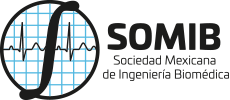Segmentación automática de cerebros en imágenes de resonancia magnética usando superficies deformables
Abstract
An automatic method to segment the brain and cerebellum into volumetric magnetic resonant images of T1 type is presented. This method is based on distortable surfaces, which are represented by closed triangular meshes. The process starts by determining on a subject’s image the sub-volume that limits the region of the head that is of interest for us. After this, a mesh M is placed into the subvolume, nearby the outer part of the head. This mesh is gradually distorted by applying local forces to each one of its vertexes. The forces are generated using information got a priori of a standard brain image, this information is a set of reference meshes and vectors obtained from positions of the vertexes. Distorting forces applied to M can be regulated by using the information for first adjusting the mesh to the outside of the head, then to the inside of the head and finally to the region that contains the brain and the cerebellum. The segmented image is finally obtained when the voxels inside the mesh are identified. The accuracy of this method is evaluated in real images and the results are compared against other automatic segmentation methods. Tests do show that this method is robust, even with images without homogeneity and preset parameters of the algorithm do not have to be modified to keep the quality of the segmentation with a relatively short time of the process.
Downloads
Downloads
Published
How to Cite
Issue
Section
License
Upon acceptance of an article in the RMIB, corresponding authors will be asked to fulfill and sign the copyright and the journal publishing agreement, which will allow the RMIB authorization to publish this document in any media without limitations and without any cost. Authors may reuse parts of the paper in other documents and reproduce part or all of it for their personal use as long as a bibliographic reference is made to the RMIB. However written permission of the Publisher is required for resale or distribution outside the corresponding author institution and for all other derivative works, including compilations and translations.



